Management Accounting: Systems, Reporting, and Cost Analysis
VerifiedAdded on 2023/01/18
|13
|3994
|42
AI Summary
This document provides a comprehensive guide to management accounting, covering topics such as systems, reporting, cost analysis, budgets, and pricing strategies. It explores the benefits of different systems and reports, and their relevance to KEF Ltd. It also discusses various cost analysis techniques and the role of costing in setting prices. Additionally, it provides insights into different types of budgets and alternative budgeting methods. Finally, it offers an overview of different pricing strategies.
Contribute Materials
Your contribution can guide someone’s learning journey. Share your
documents today.

Management Accounting
Secure Best Marks with AI Grader
Need help grading? Try our AI Grader for instant feedback on your assignments.
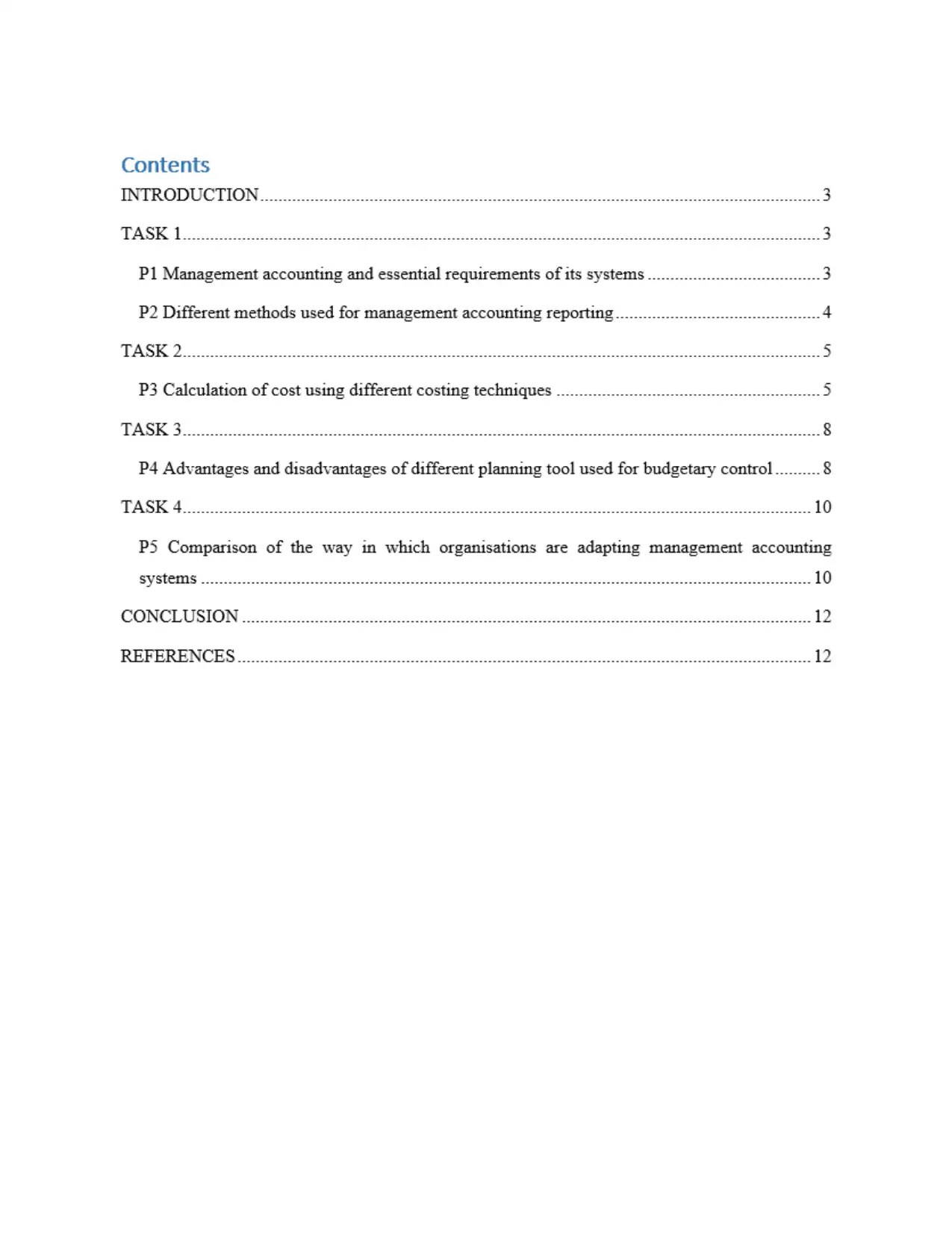
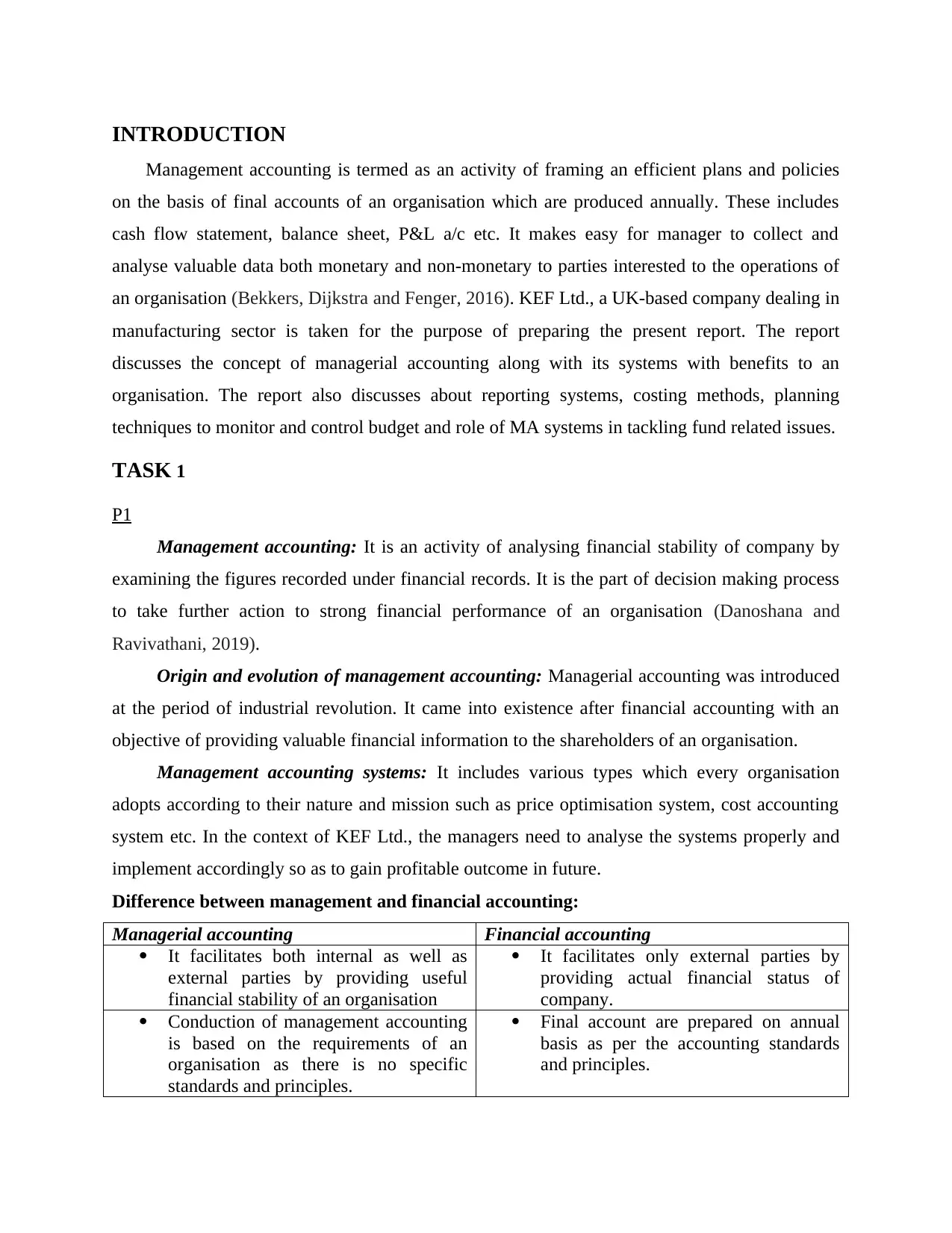
INTRODUCTION
Management accounting is termed as an activity of framing an efficient plans and policies
on the basis of final accounts of an organisation which are produced annually. These includes
cash flow statement, balance sheet, P&L a/c etc. It makes easy for manager to collect and
analyse valuable data both monetary and non-monetary to parties interested to the operations of
an organisation (Bekkers, Dijkstra and Fenger, 2016). KEF Ltd., a UK-based company dealing in
manufacturing sector is taken for the purpose of preparing the present report. The report
discusses the concept of managerial accounting along with its systems with benefits to an
organisation. The report also discusses about reporting systems, costing methods, planning
techniques to monitor and control budget and role of MA systems in tackling fund related issues.
TASK 1
P1
Management accounting: It is an activity of analysing financial stability of company by
examining the figures recorded under financial records. It is the part of decision making process
to take further action to strong financial performance of an organisation (Danoshana and
Ravivathani, 2019).
Origin and evolution of management accounting: Managerial accounting was introduced
at the period of industrial revolution. It came into existence after financial accounting with an
objective of providing valuable financial information to the shareholders of an organisation.
Management accounting systems: It includes various types which every organisation
adopts according to their nature and mission such as price optimisation system, cost accounting
system etc. In the context of KEF Ltd., the managers need to analyse the systems properly and
implement accordingly so as to gain profitable outcome in future.
Difference between management and financial accounting:
Managerial accounting Financial accounting
It facilitates both internal as well as
external parties by providing useful
financial stability of an organisation
It facilitates only external parties by
providing actual financial status of
company.
Conduction of management accounting
is based on the requirements of an
organisation as there is no specific
standards and principles.
Final account are prepared on annual
basis as per the accounting standards
and principles.
Management accounting is termed as an activity of framing an efficient plans and policies
on the basis of final accounts of an organisation which are produced annually. These includes
cash flow statement, balance sheet, P&L a/c etc. It makes easy for manager to collect and
analyse valuable data both monetary and non-monetary to parties interested to the operations of
an organisation (Bekkers, Dijkstra and Fenger, 2016). KEF Ltd., a UK-based company dealing in
manufacturing sector is taken for the purpose of preparing the present report. The report
discusses the concept of managerial accounting along with its systems with benefits to an
organisation. The report also discusses about reporting systems, costing methods, planning
techniques to monitor and control budget and role of MA systems in tackling fund related issues.
TASK 1
P1
Management accounting: It is an activity of analysing financial stability of company by
examining the figures recorded under financial records. It is the part of decision making process
to take further action to strong financial performance of an organisation (Danoshana and
Ravivathani, 2019).
Origin and evolution of management accounting: Managerial accounting was introduced
at the period of industrial revolution. It came into existence after financial accounting with an
objective of providing valuable financial information to the shareholders of an organisation.
Management accounting systems: It includes various types which every organisation
adopts according to their nature and mission such as price optimisation system, cost accounting
system etc. In the context of KEF Ltd., the managers need to analyse the systems properly and
implement accordingly so as to gain profitable outcome in future.
Difference between management and financial accounting:
Managerial accounting Financial accounting
It facilitates both internal as well as
external parties by providing useful
financial stability of an organisation
It facilitates only external parties by
providing actual financial status of
company.
Conduction of management accounting
is based on the requirements of an
organisation as there is no specific
standards and principles.
Final account are prepared on annual
basis as per the accounting standards
and principles.
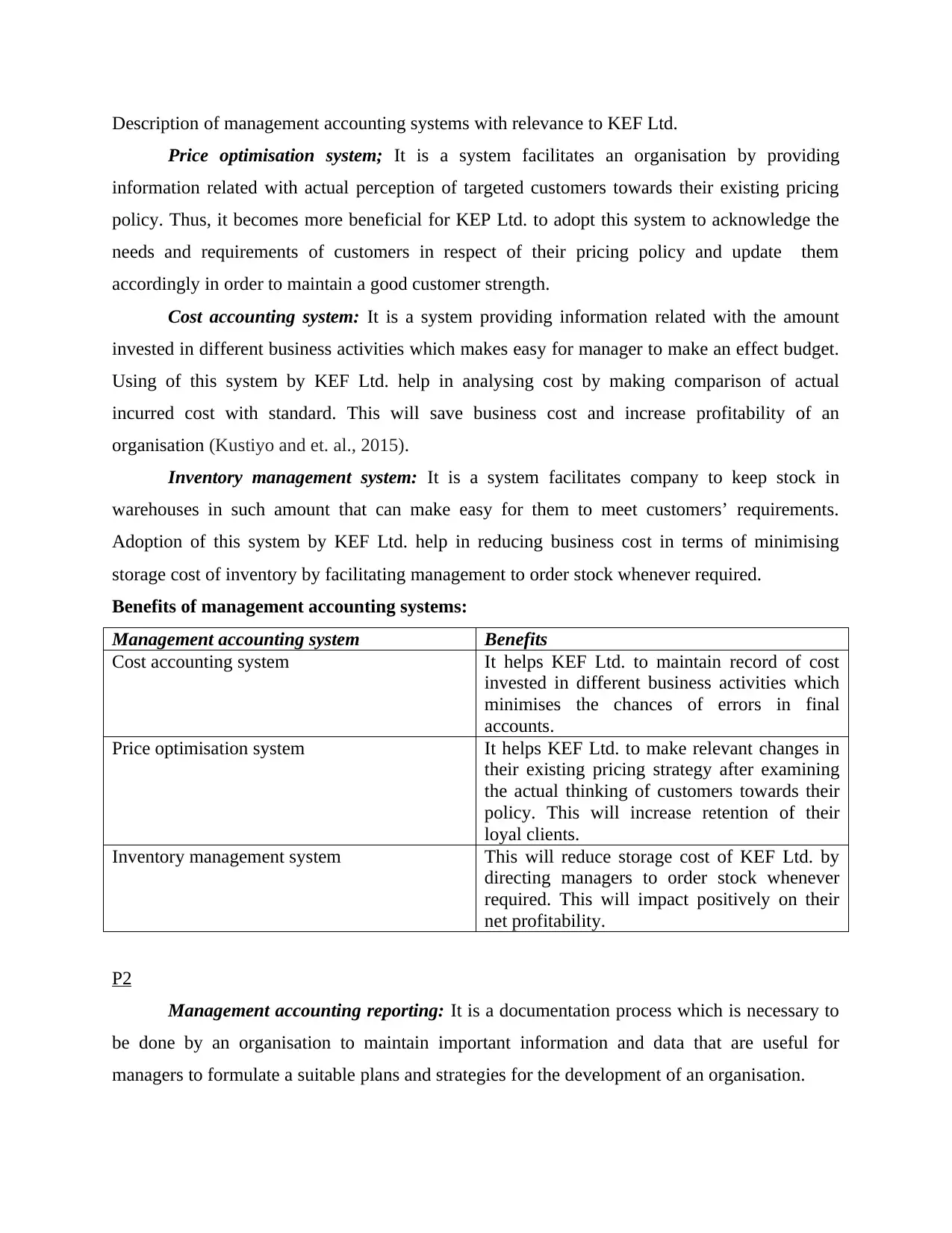
Description of management accounting systems with relevance to KEF Ltd.
Price optimisation system; It is a system facilitates an organisation by providing
information related with actual perception of targeted customers towards their existing pricing
policy. Thus, it becomes more beneficial for KEP Ltd. to adopt this system to acknowledge the
needs and requirements of customers in respect of their pricing policy and update them
accordingly in order to maintain a good customer strength.
Cost accounting system: It is a system providing information related with the amount
invested in different business activities which makes easy for manager to make an effect budget.
Using of this system by KEF Ltd. help in analysing cost by making comparison of actual
incurred cost with standard. This will save business cost and increase profitability of an
organisation (Kustiyo and et. al., 2015).
Inventory management system: It is a system facilitates company to keep stock in
warehouses in such amount that can make easy for them to meet customers’ requirements.
Adoption of this system by KEF Ltd. help in reducing business cost in terms of minimising
storage cost of inventory by facilitating management to order stock whenever required.
Benefits of management accounting systems:
Management accounting system Benefits
Cost accounting system It helps KEF Ltd. to maintain record of cost
invested in different business activities which
minimises the chances of errors in final
accounts.
Price optimisation system It helps KEF Ltd. to make relevant changes in
their existing pricing strategy after examining
the actual thinking of customers towards their
policy. This will increase retention of their
loyal clients.
Inventory management system This will reduce storage cost of KEF Ltd. by
directing managers to order stock whenever
required. This will impact positively on their
net profitability.
P2
Management accounting reporting: It is a documentation process which is necessary to
be done by an organisation to maintain important information and data that are useful for
managers to formulate a suitable plans and strategies for the development of an organisation.
Price optimisation system; It is a system facilitates an organisation by providing
information related with actual perception of targeted customers towards their existing pricing
policy. Thus, it becomes more beneficial for KEP Ltd. to adopt this system to acknowledge the
needs and requirements of customers in respect of their pricing policy and update them
accordingly in order to maintain a good customer strength.
Cost accounting system: It is a system providing information related with the amount
invested in different business activities which makes easy for manager to make an effect budget.
Using of this system by KEF Ltd. help in analysing cost by making comparison of actual
incurred cost with standard. This will save business cost and increase profitability of an
organisation (Kustiyo and et. al., 2015).
Inventory management system: It is a system facilitates company to keep stock in
warehouses in such amount that can make easy for them to meet customers’ requirements.
Adoption of this system by KEF Ltd. help in reducing business cost in terms of minimising
storage cost of inventory by facilitating management to order stock whenever required.
Benefits of management accounting systems:
Management accounting system Benefits
Cost accounting system It helps KEF Ltd. to maintain record of cost
invested in different business activities which
minimises the chances of errors in final
accounts.
Price optimisation system It helps KEF Ltd. to make relevant changes in
their existing pricing strategy after examining
the actual thinking of customers towards their
policy. This will increase retention of their
loyal clients.
Inventory management system This will reduce storage cost of KEF Ltd. by
directing managers to order stock whenever
required. This will impact positively on their
net profitability.
P2
Management accounting reporting: It is a documentation process which is necessary to
be done by an organisation to maintain important information and data that are useful for
managers to formulate a suitable plans and strategies for the development of an organisation.
Secure Best Marks with AI Grader
Need help grading? Try our AI Grader for instant feedback on your assignments.
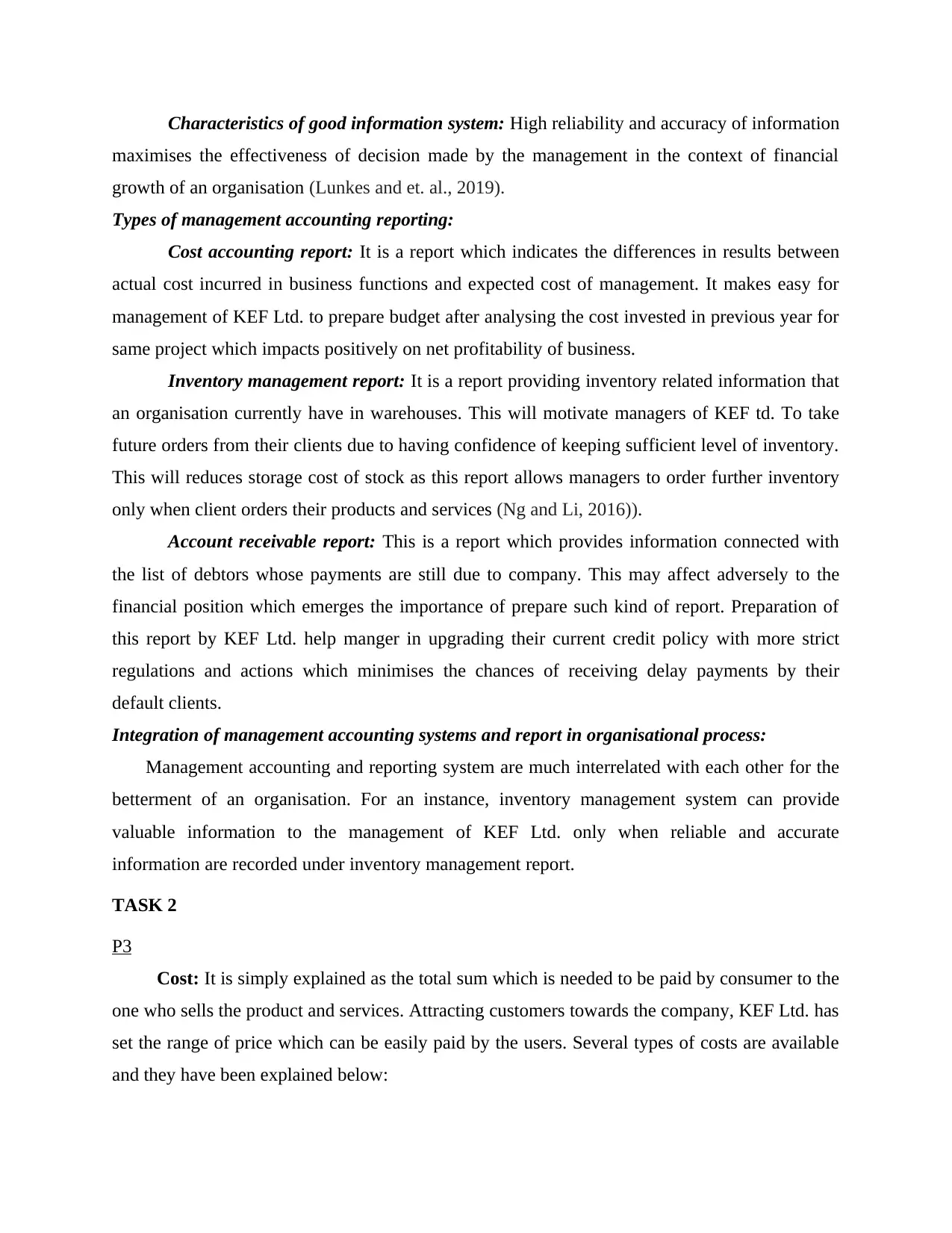
Characteristics of good information system: High reliability and accuracy of information
maximises the effectiveness of decision made by the management in the context of financial
growth of an organisation (Lunkes and et. al., 2019).
Types of management accounting reporting:
Cost accounting report: It is a report which indicates the differences in results between
actual cost incurred in business functions and expected cost of management. It makes easy for
management of KEF Ltd. to prepare budget after analysing the cost invested in previous year for
same project which impacts positively on net profitability of business.
Inventory management report: It is a report providing inventory related information that
an organisation currently have in warehouses. This will motivate managers of KEF td. To take
future orders from their clients due to having confidence of keeping sufficient level of inventory.
This will reduces storage cost of stock as this report allows managers to order further inventory
only when client orders their products and services (Ng and Li, 2016)).
Account receivable report: This is a report which provides information connected with
the list of debtors whose payments are still due to company. This may affect adversely to the
financial position which emerges the importance of prepare such kind of report. Preparation of
this report by KEF Ltd. help manger in upgrading their current credit policy with more strict
regulations and actions which minimises the chances of receiving delay payments by their
default clients.
Integration of management accounting systems and report in organisational process:
Management accounting and reporting system are much interrelated with each other for the
betterment of an organisation. For an instance, inventory management system can provide
valuable information to the management of KEF Ltd. only when reliable and accurate
information are recorded under inventory management report.
TASK 2
P3
Cost: It is simply explained as the total sum which is needed to be paid by consumer to the
one who sells the product and services. Attracting customers towards the company, KEF Ltd. has
set the range of price which can be easily paid by the users. Several types of costs are available
and they have been explained below:
maximises the effectiveness of decision made by the management in the context of financial
growth of an organisation (Lunkes and et. al., 2019).
Types of management accounting reporting:
Cost accounting report: It is a report which indicates the differences in results between
actual cost incurred in business functions and expected cost of management. It makes easy for
management of KEF Ltd. to prepare budget after analysing the cost invested in previous year for
same project which impacts positively on net profitability of business.
Inventory management report: It is a report providing inventory related information that
an organisation currently have in warehouses. This will motivate managers of KEF td. To take
future orders from their clients due to having confidence of keeping sufficient level of inventory.
This will reduces storage cost of stock as this report allows managers to order further inventory
only when client orders their products and services (Ng and Li, 2016)).
Account receivable report: This is a report which provides information connected with
the list of debtors whose payments are still due to company. This may affect adversely to the
financial position which emerges the importance of prepare such kind of report. Preparation of
this report by KEF Ltd. help manger in upgrading their current credit policy with more strict
regulations and actions which minimises the chances of receiving delay payments by their
default clients.
Integration of management accounting systems and report in organisational process:
Management accounting and reporting system are much interrelated with each other for the
betterment of an organisation. For an instance, inventory management system can provide
valuable information to the management of KEF Ltd. only when reliable and accurate
information are recorded under inventory management report.
TASK 2
P3
Cost: It is simply explained as the total sum which is needed to be paid by consumer to the
one who sells the product and services. Attracting customers towards the company, KEF Ltd. has
set the range of price which can be easily paid by the users. Several types of costs are available
and they have been explained below:
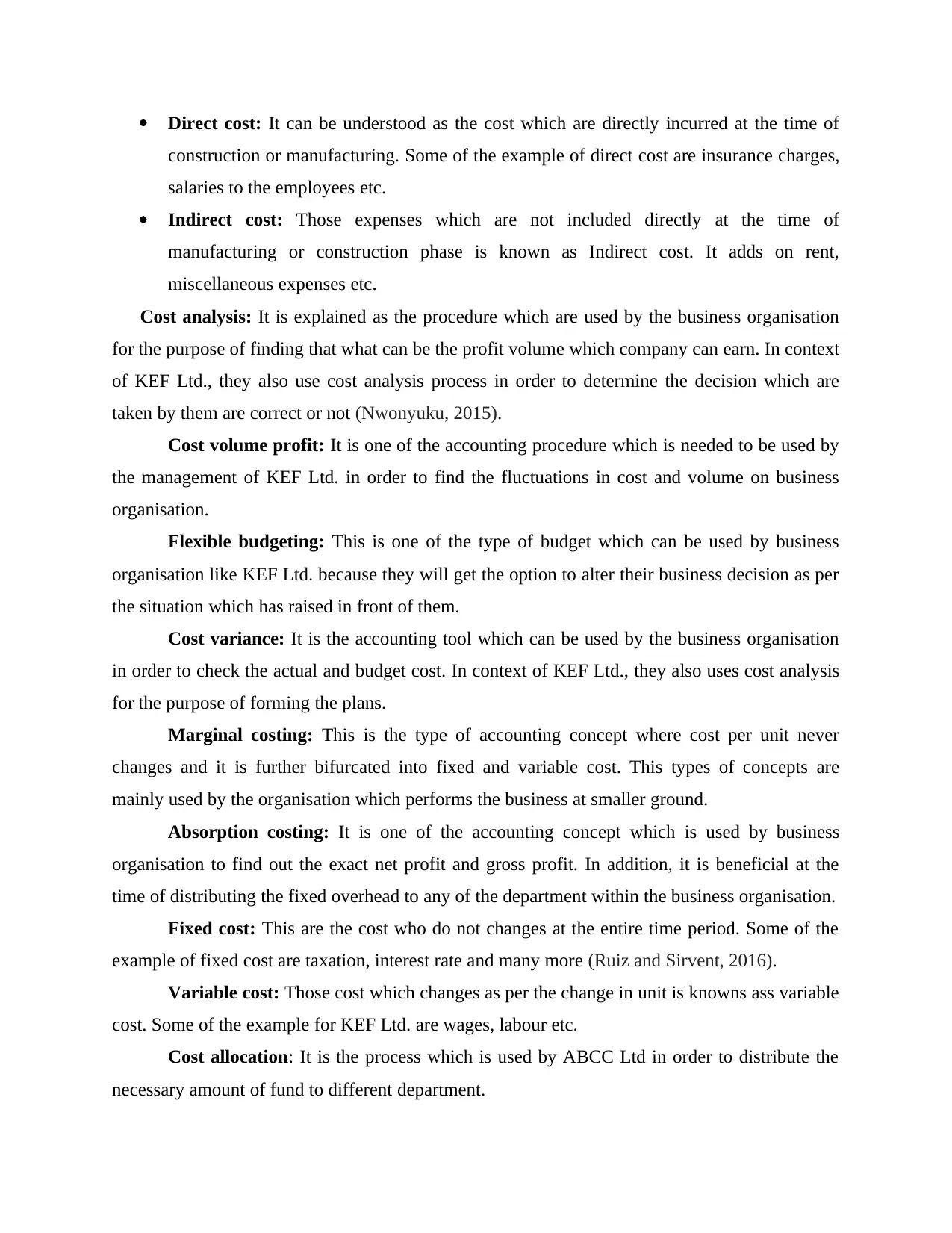
Direct cost: It can be understood as the cost which are directly incurred at the time of
construction or manufacturing. Some of the example of direct cost are insurance charges,
salaries to the employees etc.
Indirect cost: Those expenses which are not included directly at the time of
manufacturing or construction phase is known as Indirect cost. It adds on rent,
miscellaneous expenses etc.
Cost analysis: It is explained as the procedure which are used by the business organisation
for the purpose of finding that what can be the profit volume which company can earn. In context
of KEF Ltd., they also use cost analysis process in order to determine the decision which are
taken by them are correct or not (Nwonyuku, 2015).
Cost volume profit: It is one of the accounting procedure which is needed to be used by
the management of KEF Ltd. in order to find the fluctuations in cost and volume on business
organisation.
Flexible budgeting: This is one of the type of budget which can be used by business
organisation like KEF Ltd. because they will get the option to alter their business decision as per
the situation which has raised in front of them.
Cost variance: It is the accounting tool which can be used by the business organisation
in order to check the actual and budget cost. In context of KEF Ltd., they also uses cost analysis
for the purpose of forming the plans.
Marginal costing: This is the type of accounting concept where cost per unit never
changes and it is further bifurcated into fixed and variable cost. This types of concepts are
mainly used by the organisation which performs the business at smaller ground.
Absorption costing: It is one of the accounting concept which is used by business
organisation to find out the exact net profit and gross profit. In addition, it is beneficial at the
time of distributing the fixed overhead to any of the department within the business organisation.
Fixed cost: This are the cost who do not changes at the entire time period. Some of the
example of fixed cost are taxation, interest rate and many more (Ruiz and Sirvent, 2016).
Variable cost: Those cost which changes as per the change in unit is knowns ass variable
cost. Some of the example for KEF Ltd. are wages, labour etc.
Cost allocation: It is the process which is used by ABCC Ltd in order to distribute the
necessary amount of fund to different department.
construction or manufacturing. Some of the example of direct cost are insurance charges,
salaries to the employees etc.
Indirect cost: Those expenses which are not included directly at the time of
manufacturing or construction phase is known as Indirect cost. It adds on rent,
miscellaneous expenses etc.
Cost analysis: It is explained as the procedure which are used by the business organisation
for the purpose of finding that what can be the profit volume which company can earn. In context
of KEF Ltd., they also use cost analysis process in order to determine the decision which are
taken by them are correct or not (Nwonyuku, 2015).
Cost volume profit: It is one of the accounting procedure which is needed to be used by
the management of KEF Ltd. in order to find the fluctuations in cost and volume on business
organisation.
Flexible budgeting: This is one of the type of budget which can be used by business
organisation like KEF Ltd. because they will get the option to alter their business decision as per
the situation which has raised in front of them.
Cost variance: It is the accounting tool which can be used by the business organisation
in order to check the actual and budget cost. In context of KEF Ltd., they also uses cost analysis
for the purpose of forming the plans.
Marginal costing: This is the type of accounting concept where cost per unit never
changes and it is further bifurcated into fixed and variable cost. This types of concepts are
mainly used by the organisation which performs the business at smaller ground.
Absorption costing: It is one of the accounting concept which is used by business
organisation to find out the exact net profit and gross profit. In addition, it is beneficial at the
time of distributing the fixed overhead to any of the department within the business organisation.
Fixed cost: This are the cost who do not changes at the entire time period. Some of the
example of fixed cost are taxation, interest rate and many more (Ruiz and Sirvent, 2016).
Variable cost: Those cost which changes as per the change in unit is knowns ass variable
cost. Some of the example for KEF Ltd. are wages, labour etc.
Cost allocation: It is the process which is used by ABCC Ltd in order to distribute the
necessary amount of fund to different department.
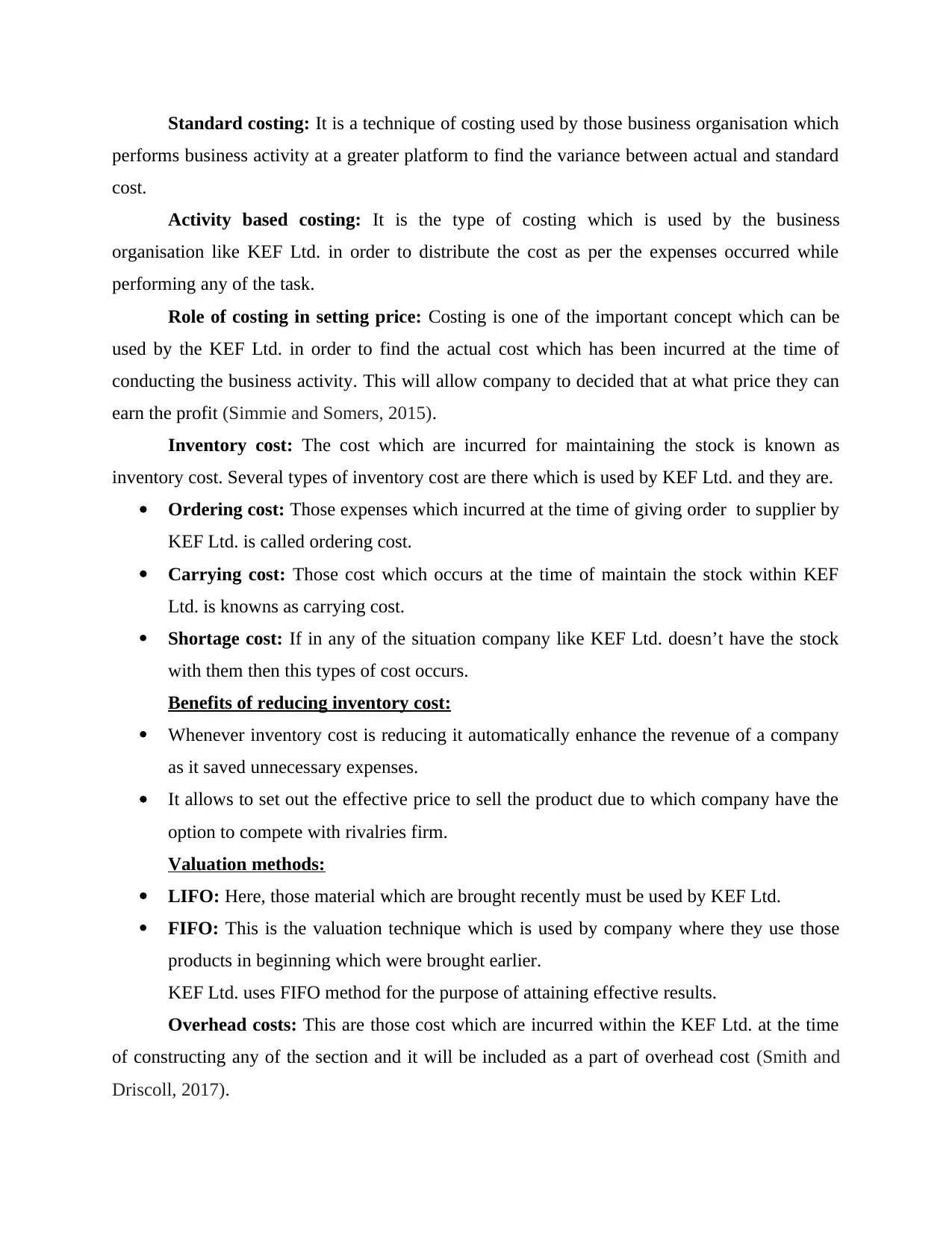
Standard costing: It is a technique of costing used by those business organisation which
performs business activity at a greater platform to find the variance between actual and standard
cost.
Activity based costing: It is the type of costing which is used by the business
organisation like KEF Ltd. in order to distribute the cost as per the expenses occurred while
performing any of the task.
Role of costing in setting price: Costing is one of the important concept which can be
used by the KEF Ltd. in order to find the actual cost which has been incurred at the time of
conducting the business activity. This will allow company to decided that at what price they can
earn the profit (Simmie and Somers, 2015).
Inventory cost: The cost which are incurred for maintaining the stock is known as
inventory cost. Several types of inventory cost are there which is used by KEF Ltd. and they are.
Ordering cost: Those expenses which incurred at the time of giving order to supplier by
KEF Ltd. is called ordering cost.
Carrying cost: Those cost which occurs at the time of maintain the stock within KEF
Ltd. is knowns as carrying cost.
Shortage cost: If in any of the situation company like KEF Ltd. doesn’t have the stock
with them then this types of cost occurs.
Benefits of reducing inventory cost:
Whenever inventory cost is reducing it automatically enhance the revenue of a company
as it saved unnecessary expenses.
It allows to set out the effective price to sell the product due to which company have the
option to compete with rivalries firm.
Valuation methods:
LIFO: Here, those material which are brought recently must be used by KEF Ltd.
FIFO: This is the valuation technique which is used by company where they use those
products in beginning which were brought earlier.
KEF Ltd. uses FIFO method for the purpose of attaining effective results.
Overhead costs: This are those cost which are incurred within the KEF Ltd. at the time
of constructing any of the section and it will be included as a part of overhead cost (Smith and
Driscoll, 2017).
performs business activity at a greater platform to find the variance between actual and standard
cost.
Activity based costing: It is the type of costing which is used by the business
organisation like KEF Ltd. in order to distribute the cost as per the expenses occurred while
performing any of the task.
Role of costing in setting price: Costing is one of the important concept which can be
used by the KEF Ltd. in order to find the actual cost which has been incurred at the time of
conducting the business activity. This will allow company to decided that at what price they can
earn the profit (Simmie and Somers, 2015).
Inventory cost: The cost which are incurred for maintaining the stock is known as
inventory cost. Several types of inventory cost are there which is used by KEF Ltd. and they are.
Ordering cost: Those expenses which incurred at the time of giving order to supplier by
KEF Ltd. is called ordering cost.
Carrying cost: Those cost which occurs at the time of maintain the stock within KEF
Ltd. is knowns as carrying cost.
Shortage cost: If in any of the situation company like KEF Ltd. doesn’t have the stock
with them then this types of cost occurs.
Benefits of reducing inventory cost:
Whenever inventory cost is reducing it automatically enhance the revenue of a company
as it saved unnecessary expenses.
It allows to set out the effective price to sell the product due to which company have the
option to compete with rivalries firm.
Valuation methods:
LIFO: Here, those material which are brought recently must be used by KEF Ltd.
FIFO: This is the valuation technique which is used by company where they use those
products in beginning which were brought earlier.
KEF Ltd. uses FIFO method for the purpose of attaining effective results.
Overhead costs: This are those cost which are incurred within the KEF Ltd. at the time
of constructing any of the section and it will be included as a part of overhead cost (Smith and
Driscoll, 2017).
Paraphrase This Document
Need a fresh take? Get an instant paraphrase of this document with our AI Paraphraser
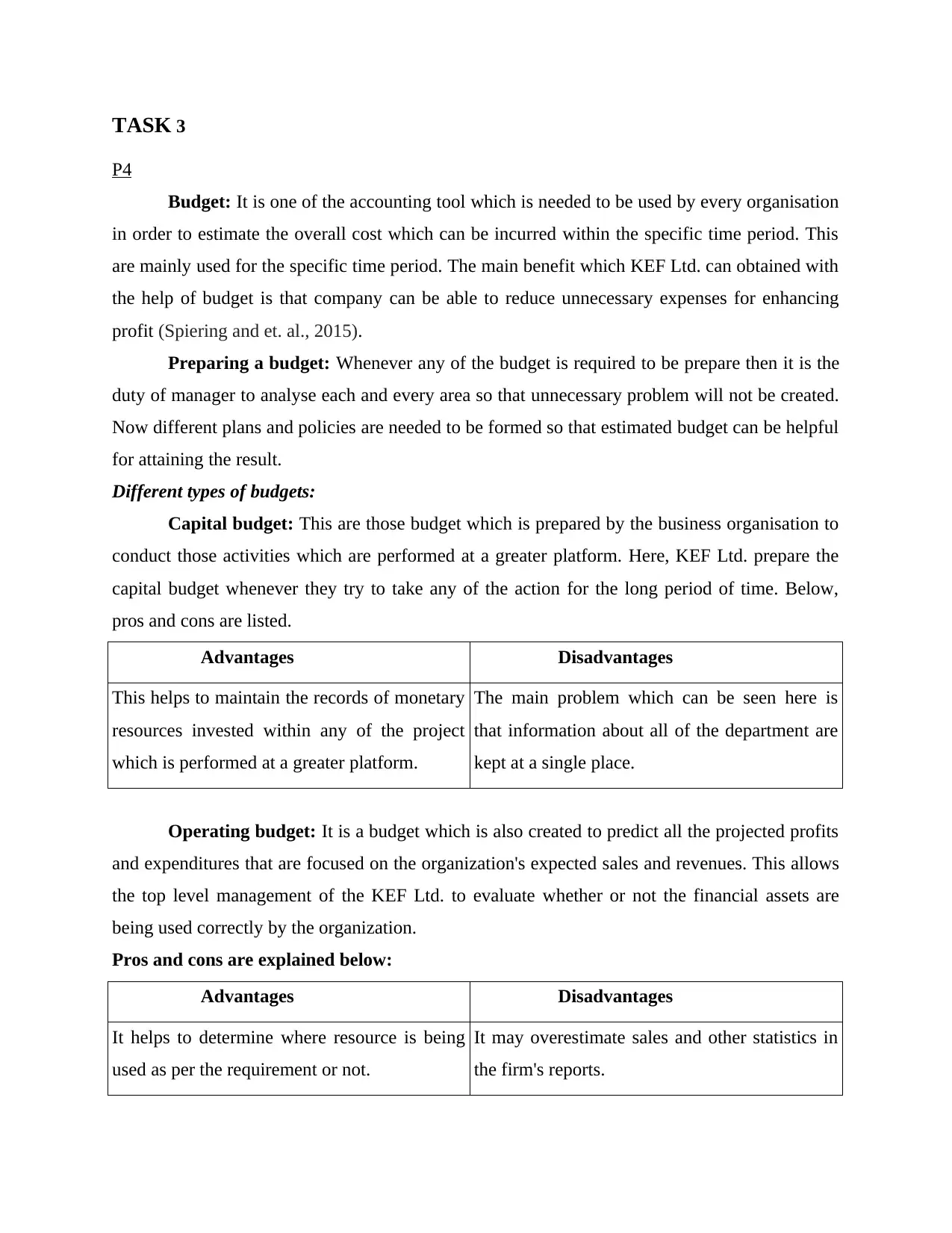
TASK 3
P4
Budget: It is one of the accounting tool which is needed to be used by every organisation
in order to estimate the overall cost which can be incurred within the specific time period. This
are mainly used for the specific time period. The main benefit which KEF Ltd. can obtained with
the help of budget is that company can be able to reduce unnecessary expenses for enhancing
profit (Spiering and et. al., 2015).
Preparing a budget: Whenever any of the budget is required to be prepare then it is the
duty of manager to analyse each and every area so that unnecessary problem will not be created.
Now different plans and policies are needed to be formed so that estimated budget can be helpful
for attaining the result.
Different types of budgets:
Capital budget: This are those budget which is prepared by the business organisation to
conduct those activities which are performed at a greater platform. Here, KEF Ltd. prepare the
capital budget whenever they try to take any of the action for the long period of time. Below,
pros and cons are listed.
Advantages Disadvantages
This helps to maintain the records of monetary
resources invested within any of the project
which is performed at a greater platform.
The main problem which can be seen here is
that information about all of the department are
kept at a single place.
Operating budget: It is a budget which is also created to predict all the projected profits
and expenditures that are focused on the organization's expected sales and revenues. This allows
the top level management of the KEF Ltd. to evaluate whether or not the financial assets are
being used correctly by the organization.
Pros and cons are explained below:
Advantages Disadvantages
It helps to determine where resource is being
used as per the requirement or not.
It may overestimate sales and other statistics in
the firm's reports.
P4
Budget: It is one of the accounting tool which is needed to be used by every organisation
in order to estimate the overall cost which can be incurred within the specific time period. This
are mainly used for the specific time period. The main benefit which KEF Ltd. can obtained with
the help of budget is that company can be able to reduce unnecessary expenses for enhancing
profit (Spiering and et. al., 2015).
Preparing a budget: Whenever any of the budget is required to be prepare then it is the
duty of manager to analyse each and every area so that unnecessary problem will not be created.
Now different plans and policies are needed to be formed so that estimated budget can be helpful
for attaining the result.
Different types of budgets:
Capital budget: This are those budget which is prepared by the business organisation to
conduct those activities which are performed at a greater platform. Here, KEF Ltd. prepare the
capital budget whenever they try to take any of the action for the long period of time. Below,
pros and cons are listed.
Advantages Disadvantages
This helps to maintain the records of monetary
resources invested within any of the project
which is performed at a greater platform.
The main problem which can be seen here is
that information about all of the department are
kept at a single place.
Operating budget: It is a budget which is also created to predict all the projected profits
and expenditures that are focused on the organization's expected sales and revenues. This allows
the top level management of the KEF Ltd. to evaluate whether or not the financial assets are
being used correctly by the organization.
Pros and cons are explained below:
Advantages Disadvantages
It helps to determine where resource is being
used as per the requirement or not.
It may overestimate sales and other statistics in
the firm's reports.
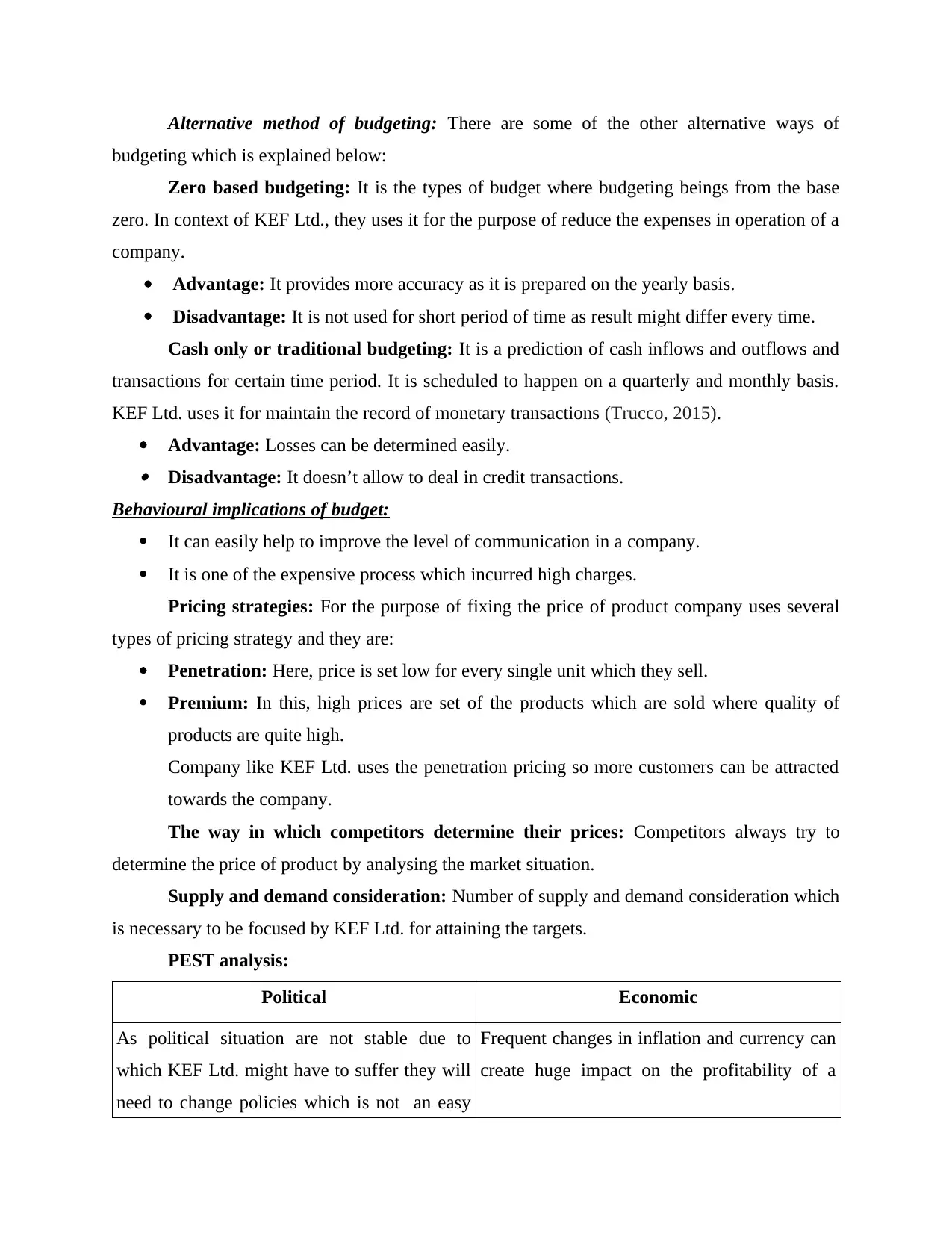
Alternative method of budgeting: There are some of the other alternative ways of
budgeting which is explained below:
Zero based budgeting: It is the types of budget where budgeting beings from the base
zero. In context of KEF Ltd., they uses it for the purpose of reduce the expenses in operation of a
company.
Advantage: It provides more accuracy as it is prepared on the yearly basis.
Disadvantage: It is not used for short period of time as result might differ every time.
Cash only or traditional budgeting: It is a prediction of cash inflows and outflows and
transactions for certain time period. It is scheduled to happen on a quarterly and monthly basis.
KEF Ltd. uses it for maintain the record of monetary transactions (Trucco, 2015).
Advantage: Losses can be determined easily. Disadvantage: It doesn’t allow to deal in credit transactions.
Behavioural implications of budget:
It can easily help to improve the level of communication in a company.
It is one of the expensive process which incurred high charges.
Pricing strategies: For the purpose of fixing the price of product company uses several
types of pricing strategy and they are:
Penetration: Here, price is set low for every single unit which they sell.
Premium: In this, high prices are set of the products which are sold where quality of
products are quite high.
Company like KEF Ltd. uses the penetration pricing so more customers can be attracted
towards the company.
The way in which competitors determine their prices: Competitors always try to
determine the price of product by analysing the market situation.
Supply and demand consideration: Number of supply and demand consideration which
is necessary to be focused by KEF Ltd. for attaining the targets.
PEST analysis:
Political Economic
As political situation are not stable due to
which KEF Ltd. might have to suffer they will
need to change policies which is not an easy
Frequent changes in inflation and currency can
create huge impact on the profitability of a
budgeting which is explained below:
Zero based budgeting: It is the types of budget where budgeting beings from the base
zero. In context of KEF Ltd., they uses it for the purpose of reduce the expenses in operation of a
company.
Advantage: It provides more accuracy as it is prepared on the yearly basis.
Disadvantage: It is not used for short period of time as result might differ every time.
Cash only or traditional budgeting: It is a prediction of cash inflows and outflows and
transactions for certain time period. It is scheduled to happen on a quarterly and monthly basis.
KEF Ltd. uses it for maintain the record of monetary transactions (Trucco, 2015).
Advantage: Losses can be determined easily. Disadvantage: It doesn’t allow to deal in credit transactions.
Behavioural implications of budget:
It can easily help to improve the level of communication in a company.
It is one of the expensive process which incurred high charges.
Pricing strategies: For the purpose of fixing the price of product company uses several
types of pricing strategy and they are:
Penetration: Here, price is set low for every single unit which they sell.
Premium: In this, high prices are set of the products which are sold where quality of
products are quite high.
Company like KEF Ltd. uses the penetration pricing so more customers can be attracted
towards the company.
The way in which competitors determine their prices: Competitors always try to
determine the price of product by analysing the market situation.
Supply and demand consideration: Number of supply and demand consideration which
is necessary to be focused by KEF Ltd. for attaining the targets.
PEST analysis:
Political Economic
As political situation are not stable due to
which KEF Ltd. might have to suffer they will
need to change policies which is not an easy
Frequent changes in inflation and currency can
create huge impact on the profitability of a
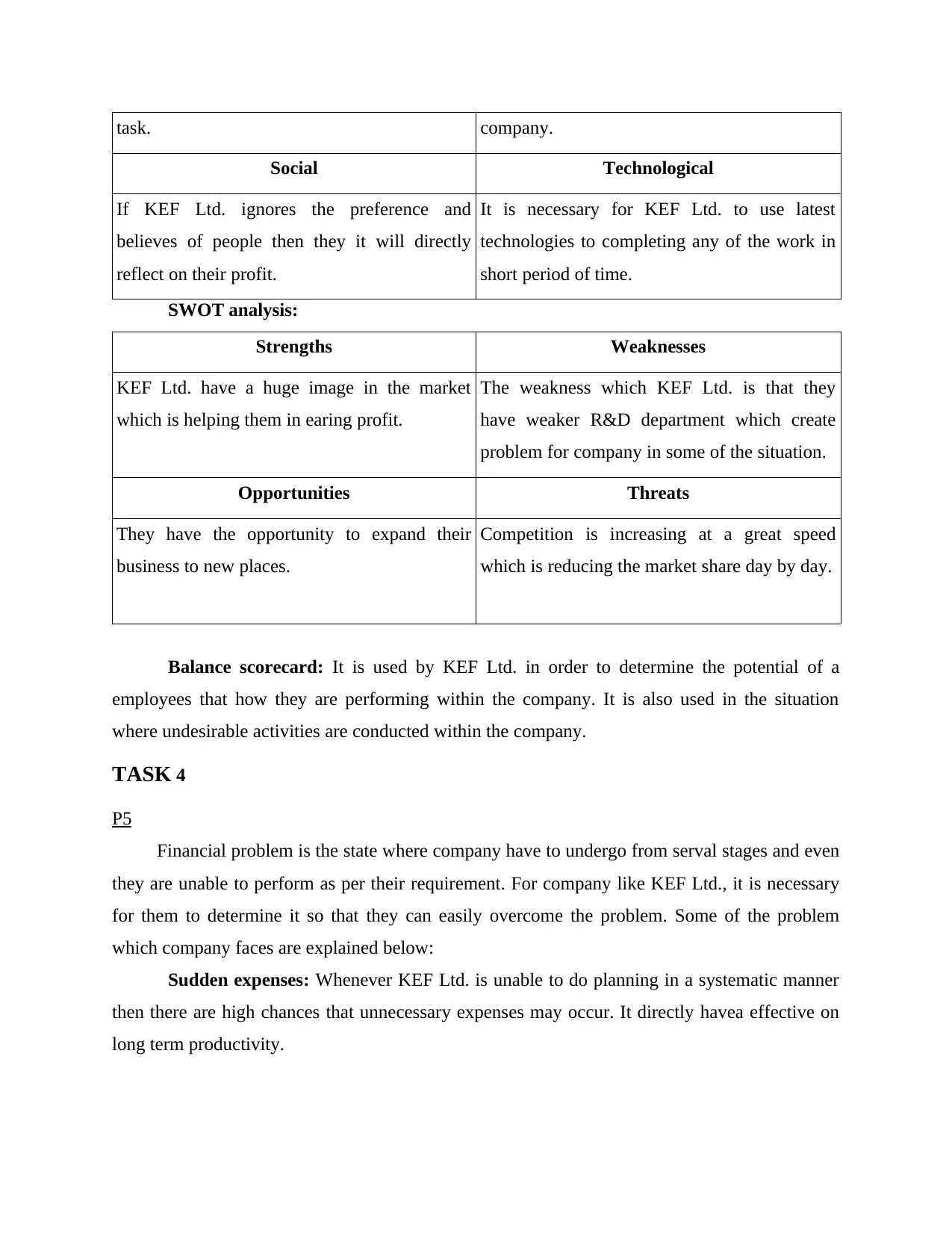
task. company.
Social Technological
If KEF Ltd. ignores the preference and
believes of people then they it will directly
reflect on their profit.
It is necessary for KEF Ltd. to use latest
technologies to completing any of the work in
short period of time.
SWOT analysis:
Strengths Weaknesses
KEF Ltd. have a huge image in the market
which is helping them in earing profit.
The weakness which KEF Ltd. is that they
have weaker R&D department which create
problem for company in some of the situation.
Opportunities Threats
They have the opportunity to expand their
business to new places.
Competition is increasing at a great speed
which is reducing the market share day by day.
Balance scorecard: It is used by KEF Ltd. in order to determine the potential of a
employees that how they are performing within the company. It is also used in the situation
where undesirable activities are conducted within the company.
TASK 4
P5
Financial problem is the state where company have to undergo from serval stages and even
they are unable to perform as per their requirement. For company like KEF Ltd., it is necessary
for them to determine it so that they can easily overcome the problem. Some of the problem
which company faces are explained below:
Sudden expenses: Whenever KEF Ltd. is unable to do planning in a systematic manner
then there are high chances that unnecessary expenses may occur. It directly havea effective on
long term productivity.
Social Technological
If KEF Ltd. ignores the preference and
believes of people then they it will directly
reflect on their profit.
It is necessary for KEF Ltd. to use latest
technologies to completing any of the work in
short period of time.
SWOT analysis:
Strengths Weaknesses
KEF Ltd. have a huge image in the market
which is helping them in earing profit.
The weakness which KEF Ltd. is that they
have weaker R&D department which create
problem for company in some of the situation.
Opportunities Threats
They have the opportunity to expand their
business to new places.
Competition is increasing at a great speed
which is reducing the market share day by day.
Balance scorecard: It is used by KEF Ltd. in order to determine the potential of a
employees that how they are performing within the company. It is also used in the situation
where undesirable activities are conducted within the company.
TASK 4
P5
Financial problem is the state where company have to undergo from serval stages and even
they are unable to perform as per their requirement. For company like KEF Ltd., it is necessary
for them to determine it so that they can easily overcome the problem. Some of the problem
which company faces are explained below:
Sudden expenses: Whenever KEF Ltd. is unable to do planning in a systematic manner
then there are high chances that unnecessary expenses may occur. It directly havea effective on
long term productivity.
Secure Best Marks with AI Grader
Need help grading? Try our AI Grader for instant feedback on your assignments.
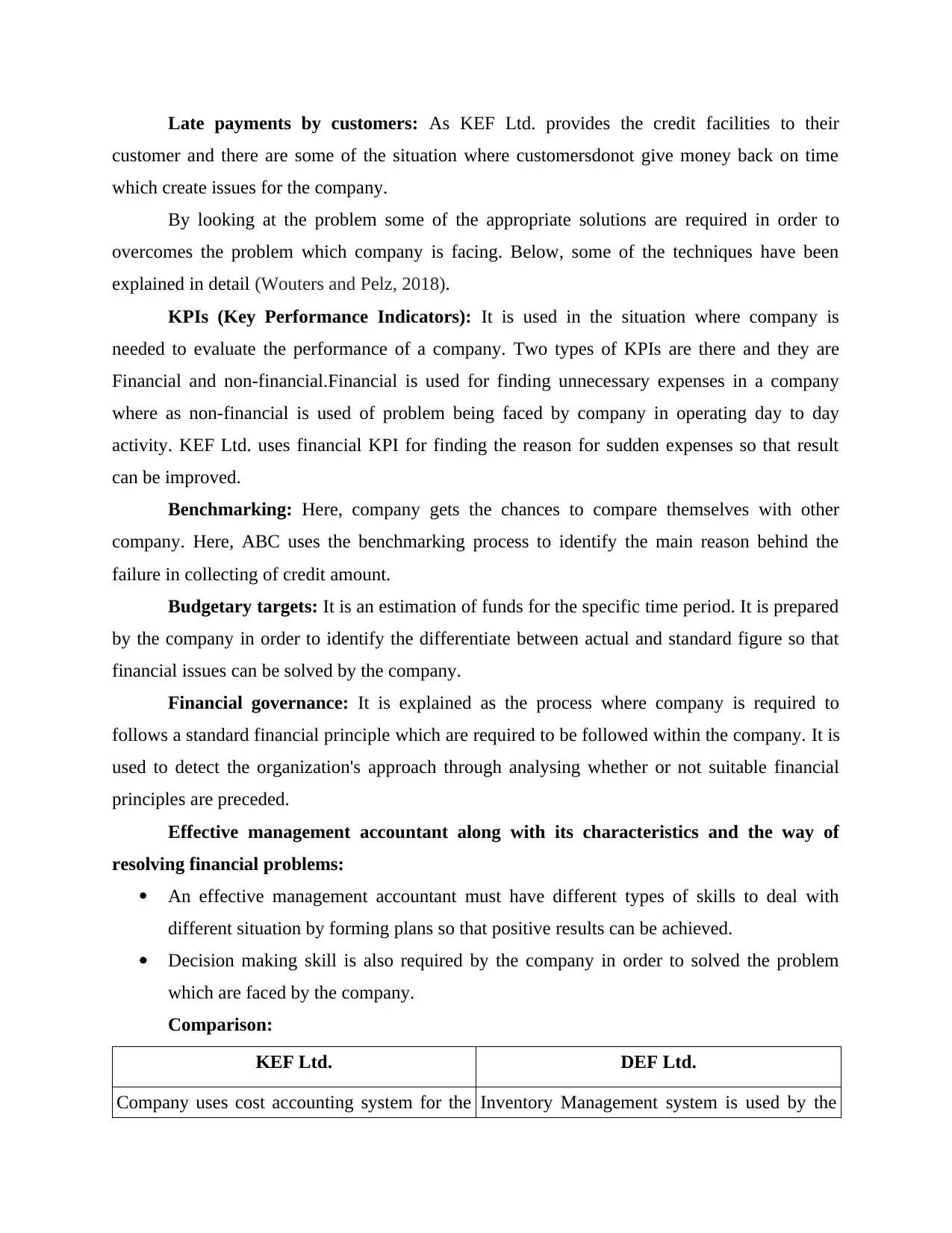
Late payments by customers: As KEF Ltd. provides the credit facilities to their
customer and there are some of the situation where customersdonot give money back on time
which create issues for the company.
By looking at the problem some of the appropriate solutions are required in order to
overcomes the problem which company is facing. Below, some of the techniques have been
explained in detail (Wouters and Pelz, 2018).
KPIs (Key Performance Indicators): It is used in the situation where company is
needed to evaluate the performance of a company. Two types of KPIs are there and they are
Financial and non-financial.Financial is used for finding unnecessary expenses in a company
where as non-financial is used of problem being faced by company in operating day to day
activity. KEF Ltd. uses financial KPI for finding the reason for sudden expenses so that result
can be improved.
Benchmarking: Here, company gets the chances to compare themselves with other
company. Here, ABC uses the benchmarking process to identify the main reason behind the
failure in collecting of credit amount.
Budgetary targets: It is an estimation of funds for the specific time period. It is prepared
by the company in order to identify the differentiate between actual and standard figure so that
financial issues can be solved by the company.
Financial governance: It is explained as the process where company is required to
follows a standard financial principle which are required to be followed within the company. It is
used to detect the organization's approach through analysing whether or not suitable financial
principles are preceded.
Effective management accountant along with its characteristics and the way of
resolving financial problems:
An effective management accountant must have different types of skills to deal with
different situation by forming plans so that positive results can be achieved.
Decision making skill is also required by the company in order to solved the problem
which are faced by the company.
Comparison:
KEF Ltd. DEF Ltd.
Company uses cost accounting system for the Inventory Management system is used by the
customer and there are some of the situation where customersdonot give money back on time
which create issues for the company.
By looking at the problem some of the appropriate solutions are required in order to
overcomes the problem which company is facing. Below, some of the techniques have been
explained in detail (Wouters and Pelz, 2018).
KPIs (Key Performance Indicators): It is used in the situation where company is
needed to evaluate the performance of a company. Two types of KPIs are there and they are
Financial and non-financial.Financial is used for finding unnecessary expenses in a company
where as non-financial is used of problem being faced by company in operating day to day
activity. KEF Ltd. uses financial KPI for finding the reason for sudden expenses so that result
can be improved.
Benchmarking: Here, company gets the chances to compare themselves with other
company. Here, ABC uses the benchmarking process to identify the main reason behind the
failure in collecting of credit amount.
Budgetary targets: It is an estimation of funds for the specific time period. It is prepared
by the company in order to identify the differentiate between actual and standard figure so that
financial issues can be solved by the company.
Financial governance: It is explained as the process where company is required to
follows a standard financial principle which are required to be followed within the company. It is
used to detect the organization's approach through analysing whether or not suitable financial
principles are preceded.
Effective management accountant along with its characteristics and the way of
resolving financial problems:
An effective management accountant must have different types of skills to deal with
different situation by forming plans so that positive results can be achieved.
Decision making skill is also required by the company in order to solved the problem
which are faced by the company.
Comparison:
KEF Ltd. DEF Ltd.
Company uses cost accounting system for the Inventory Management system is used by the
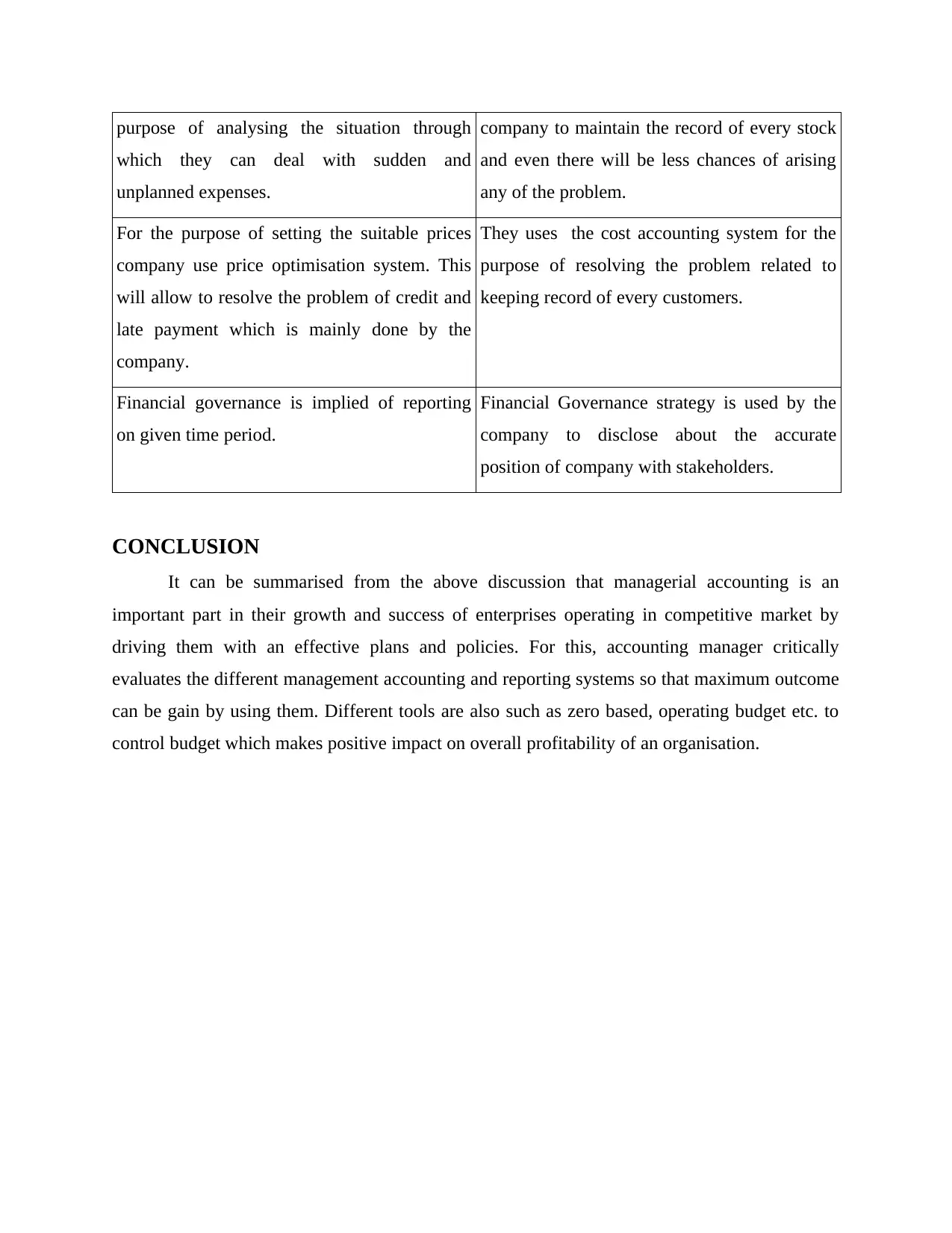
purpose of analysing the situation through
which they can deal with sudden and
unplanned expenses.
company to maintain the record of every stock
and even there will be less chances of arising
any of the problem.
For the purpose of setting the suitable prices
company use price optimisation system. This
will allow to resolve the problem of credit and
late payment which is mainly done by the
company.
They uses the cost accounting system for the
purpose of resolving the problem related to
keeping record of every customers.
Financial governance is implied of reporting
on given time period.
Financial Governance strategy is used by the
company to disclose about the accurate
position of company with stakeholders.
CONCLUSION
It can be summarised from the above discussion that managerial accounting is an
important part in their growth and success of enterprises operating in competitive market by
driving them with an effective plans and policies. For this, accounting manager critically
evaluates the different management accounting and reporting systems so that maximum outcome
can be gain by using them. Different tools are also such as zero based, operating budget etc. to
control budget which makes positive impact on overall profitability of an organisation.
which they can deal with sudden and
unplanned expenses.
company to maintain the record of every stock
and even there will be less chances of arising
any of the problem.
For the purpose of setting the suitable prices
company use price optimisation system. This
will allow to resolve the problem of credit and
late payment which is mainly done by the
company.
They uses the cost accounting system for the
purpose of resolving the problem related to
keeping record of every customers.
Financial governance is implied of reporting
on given time period.
Financial Governance strategy is used by the
company to disclose about the accurate
position of company with stakeholders.
CONCLUSION
It can be summarised from the above discussion that managerial accounting is an
important part in their growth and success of enterprises operating in competitive market by
driving them with an effective plans and policies. For this, accounting manager critically
evaluates the different management accounting and reporting systems so that maximum outcome
can be gain by using them. Different tools are also such as zero based, operating budget etc. to
control budget which makes positive impact on overall profitability of an organisation.
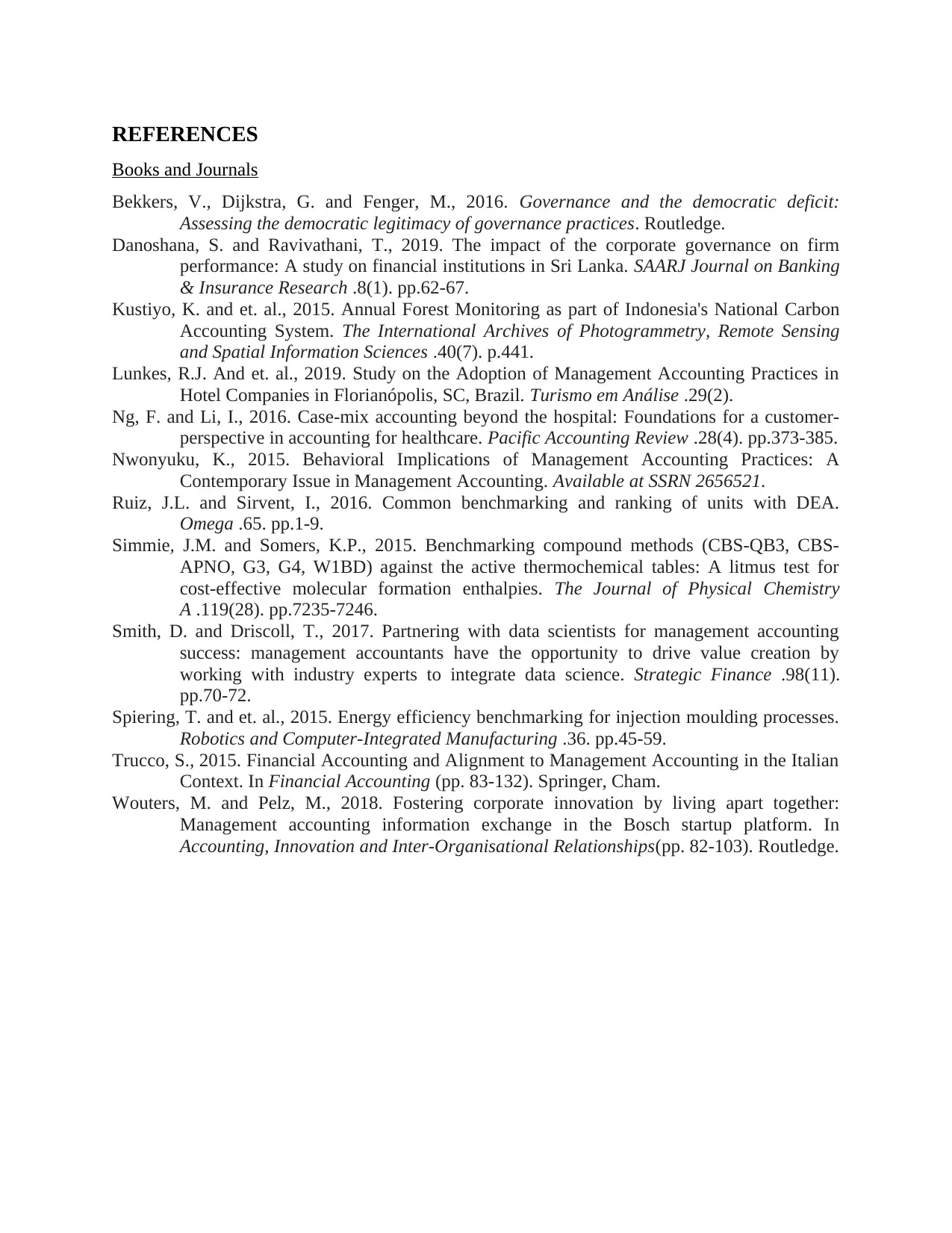
REFERENCES
Books and Journals
Bekkers, V., Dijkstra, G. and Fenger, M., 2016. Governance and the democratic deficit:
Assessing the democratic legitimacy of governance practices. Routledge.
Danoshana, S. and Ravivathani, T., 2019. The impact of the corporate governance on firm
performance: A study on financial institutions in Sri Lanka. SAARJ Journal on Banking
& Insurance Research .8(1). pp.62-67.
Kustiyo, K. and et. al., 2015. Annual Forest Monitoring as part of Indonesia's National Carbon
Accounting System. The International Archives of Photogrammetry, Remote Sensing
and Spatial Information Sciences .40(7). p.441.
Lunkes, R.J. And et. al., 2019. Study on the Adoption of Management Accounting Practices in
Hotel Companies in Florianópolis, SC, Brazil. Turismo em Análise .29(2).
Ng, F. and Li, I., 2016. Case-mix accounting beyond the hospital: Foundations for a customer-
perspective in accounting for healthcare. Pacific Accounting Review .28(4). pp.373-385.
Nwonyuku, K., 2015. Behavioral Implications of Management Accounting Practices: A
Contemporary Issue in Management Accounting. Available at SSRN 2656521.
Ruiz, J.L. and Sirvent, I., 2016. Common benchmarking and ranking of units with DEA.
Omega .65. pp.1-9.
Simmie, J.M. and Somers, K.P., 2015. Benchmarking compound methods (CBS-QB3, CBS-
APNO, G3, G4, W1BD) against the active thermochemical tables: A litmus test for
cost-effective molecular formation enthalpies. The Journal of Physical Chemistry
A .119(28). pp.7235-7246.
Smith, D. and Driscoll, T., 2017. Partnering with data scientists for management accounting
success: management accountants have the opportunity to drive value creation by
working with industry experts to integrate data science. Strategic Finance .98(11).
pp.70-72.
Spiering, T. and et. al., 2015. Energy efficiency benchmarking for injection moulding processes.
Robotics and Computer-Integrated Manufacturing .36. pp.45-59.
Trucco, S., 2015. Financial Accounting and Alignment to Management Accounting in the Italian
Context. In Financial Accounting (pp. 83-132). Springer, Cham.
Wouters, M. and Pelz, M., 2018. Fostering corporate innovation by living apart together:
Management accounting information exchange in the Bosch startup platform. In
Accounting, Innovation and Inter-Organisational Relationships(pp. 82-103). Routledge.
Books and Journals
Bekkers, V., Dijkstra, G. and Fenger, M., 2016. Governance and the democratic deficit:
Assessing the democratic legitimacy of governance practices. Routledge.
Danoshana, S. and Ravivathani, T., 2019. The impact of the corporate governance on firm
performance: A study on financial institutions in Sri Lanka. SAARJ Journal on Banking
& Insurance Research .8(1). pp.62-67.
Kustiyo, K. and et. al., 2015. Annual Forest Monitoring as part of Indonesia's National Carbon
Accounting System. The International Archives of Photogrammetry, Remote Sensing
and Spatial Information Sciences .40(7). p.441.
Lunkes, R.J. And et. al., 2019. Study on the Adoption of Management Accounting Practices in
Hotel Companies in Florianópolis, SC, Brazil. Turismo em Análise .29(2).
Ng, F. and Li, I., 2016. Case-mix accounting beyond the hospital: Foundations for a customer-
perspective in accounting for healthcare. Pacific Accounting Review .28(4). pp.373-385.
Nwonyuku, K., 2015. Behavioral Implications of Management Accounting Practices: A
Contemporary Issue in Management Accounting. Available at SSRN 2656521.
Ruiz, J.L. and Sirvent, I., 2016. Common benchmarking and ranking of units with DEA.
Omega .65. pp.1-9.
Simmie, J.M. and Somers, K.P., 2015. Benchmarking compound methods (CBS-QB3, CBS-
APNO, G3, G4, W1BD) against the active thermochemical tables: A litmus test for
cost-effective molecular formation enthalpies. The Journal of Physical Chemistry
A .119(28). pp.7235-7246.
Smith, D. and Driscoll, T., 2017. Partnering with data scientists for management accounting
success: management accountants have the opportunity to drive value creation by
working with industry experts to integrate data science. Strategic Finance .98(11).
pp.70-72.
Spiering, T. and et. al., 2015. Energy efficiency benchmarking for injection moulding processes.
Robotics and Computer-Integrated Manufacturing .36. pp.45-59.
Trucco, S., 2015. Financial Accounting and Alignment to Management Accounting in the Italian
Context. In Financial Accounting (pp. 83-132). Springer, Cham.
Wouters, M. and Pelz, M., 2018. Fostering corporate innovation by living apart together:
Management accounting information exchange in the Bosch startup platform. In
Accounting, Innovation and Inter-Organisational Relationships(pp. 82-103). Routledge.
1 out of 13
Related Documents
Your All-in-One AI-Powered Toolkit for Academic Success.
+13062052269
info@desklib.com
Available 24*7 on WhatsApp / Email
![[object Object]](/_next/static/media/star-bottom.7253800d.svg)
Unlock your academic potential
© 2024 | Zucol Services PVT LTD | All rights reserved.





![Management Accounting Table of Content [pic]](/_next/image/?url=https%3A%2F%2Fdesklib.com%2Fmedia%2Fimages%2Fcb%2F8d835dc5046f43b1b3c649176e00fab1.jpg&w=256&q=75)